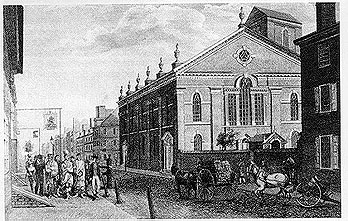




Rough estimates put German immigrants at one-third Catholic and the
other two-thirds
predominantly Lutheran and Reformed. Coparatively small in numbers were German
Methodists,
Baptists, Unitarians, Pietists, Jews and Free Thinkers. For many German
immigrants the parish
church was the center of their social lives.

The prosperity and attractiveness of a community out in the
countryside could be recognized
by its church and school structures. Each was an expression of the
initiative of local immigrants.
In 1869 John
Bauer wrote to his parents in Baden how the residents in his rural
community in Missouri all
contributed to the construction of the school house, for "of course, I
would much rather pay this
sum [$18.25] than live in a neighborhood where the
schools are poor." He went on, "As soon as this is finished, they will
probably build a new church which will naturally cost more than the
schoolhouse. It is not
compulsory, for many rich men don't give a cent for it, although they are
often blessed by
Providence with everything; there are also people here who never go to
church & think more about a nice horse than a fine church. I do not want
to take a back seat here
and if God gives me life and means, I intend to contribute my share. You
don't need to do this in
Germany, but here the government does nothing at all" [Kamphoefner,
News, 167].
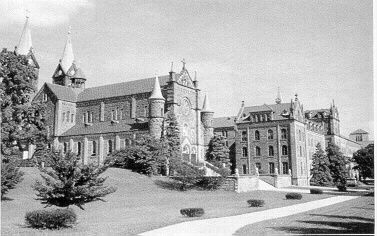
Long before public school systems were mandated by state
legislatures, the parish church
was also running a parish school. This holds true especially for the
German-language parish
churches and their private German schools. "The language is the
vessel of faith," is how church leaders explained their approach to parochial
education. They hoped to
ward off any threat to the religion of their children (which they
perceived would originate from
the English-language public schools) by keeping the German
schools under church management. Leaders in the German-speaking Catholic
parishes also built
barricades against what they perceived as a threat of domination by the
Irish-American Catholic
hierarchy. Protestant churches were the primary beneficiaries of
donations from Germany, while the German Catholics in America profited
from the personal
volunteer work of immigrant priests and religious orders. Nuns,
especially Benedictines and
Franciscans, ran their own hospitals, schools and even preparatory
seminaries for the clergy. For example, in Indiana, beginning with the
second half of the
19th century, the sisters of the Catholic teaching orders of St. Francis
and St. Benedict provided
tens of thousands of children with a German Catholic education. Around
the state today, the
sisters still operate numerous schools, although no longer as "German"
institutions.
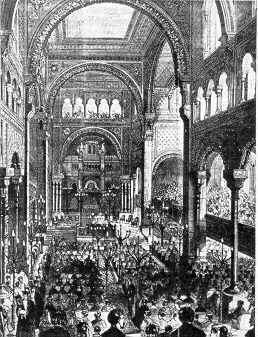
In colonial times and well into the 19th century, all German-language schools in states such as Pennsylvania, Maryland, Virginia and the Carolinas were operated as parochial schools. Not until 1850 was there any competition from public schools and a new brand of sectarian schools in the densely German settlements of the Midwest and in Texas. Private schools began to be run by Free Thinkers and other non-religious organizations. Because Germans in many towns saw little chance for transmitting either their language or their cultural heritage in the American public schools, they often founded a local German school society that functioned as legal owner of their school.
In some communities, the German schools operated according to new pedagogical principles and had a lasting impact on the American school system. Kindergarten as a pre-school, sports programs at all school levels, music, and manual arts as elements of the regular curriculum were first introduced by so-called radical-democratic German groups, such as the Socialist Turner Societies, an entity known today as the American Turners. In Milwaukee, and later in Indianapolis, this organization had its own Normal College for teachers of physical education. Some well-known schools like the Knapp School in Baltimore and the German-English Academy in Milwaukee existed into the 20th century. Examples of especially progressive schools founded by German immigrant intellectuals were the Rosler von Oels School in New York, the Zion School in Baltimore, the school system founded by Georg von Bunsen in Belleville, Illinois and many manual training high schools which combined academic and vocational education.
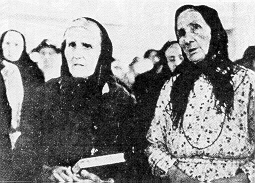 Like the Catholic church, the Missouri Synod of the Lutheran Church was
educationally very active.
It operated a half dozen high schools in a manner similar to a German
gymnasium.
Candidates for
pastoral training who first attended these schools later went on to the
distinguished
German-language Theological Seminary in St. Louis. At the same time, the
Synod maintained two
teacher training colleges to serve its private elementary and high
schools.
The only secular German-English teacher training institution existed in
Milwaukee from 1878 to 1919. This bilingual institution educated a total
of 335 teachers for instruction in private and public elementary
schools.
Like the Catholic church, the Missouri Synod of the Lutheran Church was
educationally very active.
It operated a half dozen high schools in a manner similar to a German
gymnasium.
Candidates for
pastoral training who first attended these schools later went on to the
distinguished
German-language Theological Seminary in St. Louis. At the same time, the
Synod maintained two
teacher training colleges to serve its private elementary and high
schools.
The only secular German-English teacher training institution existed in
Milwaukee from 1878 to 1919. This bilingual institution educated a total
of 335 teachers for instruction in private and public elementary
schools.
Particularly in urban settings -- and in spite of efforts to the
contrary -- the forces of integration
would eventually spell the decline of German-language preservation in the
two principal pillars of
language maintenance outside the family: the German church and the German
school. With more and more second and third generation
German-Americans outweighing by far the dwindling replenishment of new
immigrants, the need
and the preference for English became unstoppable. And when, by the late
19th
century, German had become the leading modern foreign language in high
school, many
German-American parents and school boards of non-church-related schools
felt that the expenses
of running
a private school were no longer warranted.
Following the First World War with its massive and
intimidating campaign for Americanization, practically the only
German-language instruction that
continued to exist was in the rural German-language enclaves. On
June 4,1923, the Supreme Court of the United States ruled in the case of
Meyer vs. the State of
Nebraska that a knowledge of the German language by 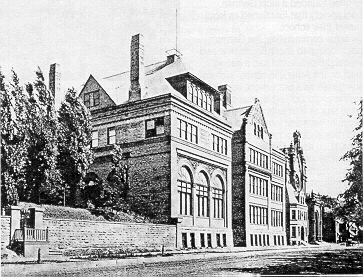 itself
could not be regarded as harmful and
that the right to teach and the right of parents to have
their children taught in a language other than English was within the
liberties guaranteed by the
Fourteenth Amendment [Rippley, 1984, p. 126]. In 1925 the Supreme
Court ruled in the case of
Pierce vs. the Sisters of the Holy Name of Jesus and Mary that children
between
the ages of eight and sixteen
were not bound to attend a public school. But even with such favorable
court decisions, German
schools were on the decline. In 1927 there were still 555 German-American
private schools with
35,000 pupils, but ten years later in 1936 there were only 281
such schools with 17,800 pupils.
itself
could not be regarded as harmful and
that the right to teach and the right of parents to have
their children taught in a language other than English was within the
liberties guaranteed by the
Fourteenth Amendment [Rippley, 1984, p. 126]. In 1925 the Supreme
Court ruled in the case of
Pierce vs. the Sisters of the Holy Name of Jesus and Mary that children
between
the ages of eight and sixteen
were not bound to attend a public school. But even with such favorable
court decisions, German
schools were on the decline. In 1927 there were still 555 German-American
private schools with
35,000 pupils, but ten years later in 1936 there were only 281
such schools with 17,800 pupils.
An unrealized dream of a few German-Americans was to have their own university with German as the language of instruction, which, it was hoped, would have attracted a varied German-language clientele of differing religious and political persuasions. But in spite of German "Kultur" enthusiasm on the part of confessional and non-confessional German-Americans, the sometimes almost militant particularism among the "Krauts" was not conducive to such an enterprise.
Concerning teacher training and other German institutions of higher education in the United States, see LaVern J. Rippley, "The German-American Normal Schools," in Erich A. Albrecht and J. Anthony Burzles eds. German Americana 1976 (Lawrence: Max Kade Document and Research Center, 1977), 63-71.


